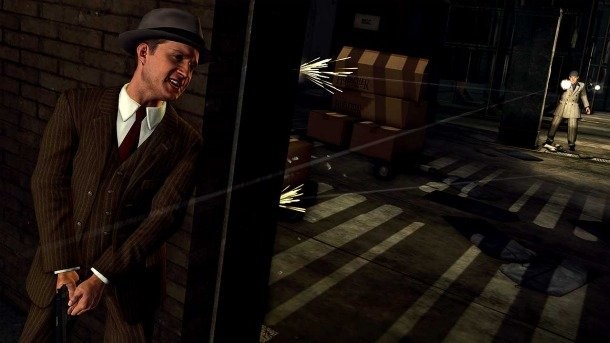Please support Game Informer. Print magazine subscriptions are less than $2 per issue
L.A. Noire

Since we gave the world its first look into the dark world of L.A. Noire with our March 2010 cover story, Rockstar has incrementally lifted the veil, each time revealing a bit more about this intriguing title. Recently, I got my first opportunity to play L.A. Noire.
Rockstar ran me through a brief interlude that showed protagonist Cole Phelps arriving at his new job at the detective desk of the LAPD (and a small sampling of a case entitled “The Red Lipstick Killer”). Phelps is introduced as the replacement to retiring detective Floyd Rose (who seems to be “retiring” under shady circumstances), and placed with Rose’s old partner, Rusty Galloway. Throughout our session, it’s clear that Galloway is not pleased to be paired with this holier-than-thou rookie.
After this introduction, I took the controller and began a new case, “The Silk Stocking Murder.” Like many of the recent trailers for the game, this case is tied to Los Angeles’ real-life Black Dahlia murders. We’re called into action by Captain Donnelly. A Hispanic woman has been found dead near city hall. The M.O. appears to be that of the Black Dahlia killer – or a copycat. As we arrive, we’re met by some sleazy reporters. “Another tramp, another message,” says one. “Is the Werewolf back in business?” (“The Werewolf” is another period nickname for the Black Dahlia killer.) Phelps is not amused, rebuffing the wags by asking them if they have a mother or sister.
The crime scene is gruesome. The woman is naked and mutilated. Inspecting her body, I see that a ring has been removed from her finger, and cryptic messages – “B.D.” and “Kiss the Blood” – have been scrawled on her torso. I begin investigating the crime scene, which is one of the game’s main play mechanics. Generally, you proceed just as you would in real life – something catches your eye, you bend down and pick it up. You can rotate items in your hand with the thumbstick, searching for a “sweet spot” that will initiate rumble and reveal a further clue in the item. For example, you might pick up an envelope and read the address on it, then open it up and check the contents inside. It works well, and if you get off track, your partner is there to spot things you miss. It’s important to scour the location for every clue, as missing things limits your options in subsequent interrogations. This particular crime scene is strange; we’re clearly being led on a path of blood stains to find objects like a library card, a ring, and other personal effects. This path takes us to a roof of a nearby building where we finally discern the identity and address of the victim: Ms. Antonia Maldonado.
From here, we head into investigation and interrogation. From Ms. Maldonaldo’s landlord to her estranged husband, we track down each person of interest in the case, asking questions based on the evidence we acquired in our searches of her residence and the crime scene. I’ve always felt that L.A. Noire’s success will ride on its ability to make these interrogations feel real and compelling. You must pay attention to each character’s facial reactions – you can’t afford to be gullible, but pressing a witness too hard makes them shut down entirely.
If you accuse someone of lying, you better have a clue to back up your claim. This is made easy by your in-game notebook, which takes automatic notes of every relevant clue, address, person of interest, and fact. If the witness rebuffs your accusation, you simply have to select the clue that proves them wrong and call them on it. Usually, they’ll give up the crucial information that takes you to your next destination. The conversation mechanics are simple and effective. Three simple button presses (indicating whether you believe them, are skeptical of their answer, or think they are outright lying to you) dictate your response. Overall, it’s similar to the system seen in Mass Effect, giving you a good sense of your reply without resorting to verbatim dialogue options.
The trail of the case takes many twists and turns – recently filed divorce papers seem to finger her husband, who has a flimsy alibi for the night she was murdered. However, further interrogation reveals that he’s not the culprit. A lead that first appeared to go nowhere – her late night visit to a green grocer to call for a cab following a night of drinking – suddenly takes a turn when I uncover a bloody scalpel in the grocer’s back room. After a quick car chase (which felt similar to the driving in GTA, making adjustments for the boaty physics of the period cars), we apprehend the grocer.
However, I got the sense that this was not the full story. Our captain seemed eager to wrap up the case, deliver the suspect to the district attorney, and write it off as a copycat murder. If it was that simple, why the elaborate trail of clues at the crime scene and the messages scrawled on her body? Is the Black Dahlia killer still stalking the women of L.A.? Sadly, I didn’t get a chance to allay these suspicions in my brief hands-on session. I have a hunch that the answers to these questions will play heavily into the larger story being told in L.A. Noire – one that is likely tied to the apparent corruption at the LAPD’s highest levels. However, there is one thing I’m increasingly sure of – L.A. Noire is going to give gamers an experience unlike anything we’ve ever played before. Conversation trumps gunplay, and the real truth is buried under layers of subterfuge. I can’t wait.











